
Bundt Cake Baking Tips
If you spend some time perusing the archives here at BoB, you’ll quickly see that I love to bake Bundt cakes. I love their simplicity and versatility, and I also love that they can be topped with a simple glaze, a sprinkling of confectioners’ sugar, or even left unadorned. No layers or elaborate decorating required!
I find that simplicity to be the beauty of Bundt cakes. It’s my mission to make baking simple with outstanding results, and that makes Bundt cakes a staple in my baking. Plus, I can’t resist all of those beautiful pan designs that turn them into eye-catching desserts!
While Bundt cakes are usually simple recipes, issues can arise because of the unique characteristics of the pans. These are my tips to ensure a Bundt cake that is both delicious and beautiful.
And because we’re all here for the cake, I’m also sharing some of BoB’s best and most popular Bundt cakes for some baking inspiration.
General Baking Tips
First, let’s cover some general baking bases. These are the tips I’ll give you about most anything you’re baking. Measure your ingredients accurately. Use quality ingredients. Check the accuracy of your oven’s temperature. Don’t use dark or shiny pans. Any substitutions you make WILL affect the final result. Now, let’s talk about some tips specific to Bundt cake baking.
Choosing a Bundt Pan
Of course, what makes a Bundt cake a Bundt cake is the pan. There are SO many different Bundt pan designs! I have several, and I’m always wanting more.
With so many pans available, the most important thing is to choose the right pan for your Bundt cake based on the recipe’s recommendation. (And as always, don’t use a dark pan!) Different Bundt pans have varying volume capacities. The recipe should tell you what size pan you need to use. I most commonly use a pan with a 12-cup capacity, but I also use other sizes like 10-cup pans and mini Bundt pans.
Using the right size pan helps prevent overflowing and ensures more even baking. If your pan is too small, you can end up with a big mess in your oven. If it’s too big, then the extra space may lead to less than optimal results with doneness and texture. If nothing else, a cake that doesn’t fill the pan when baked will not be shaped or patterned as you want.
It’s important to use the right size pan to prevent the cake from spilling out of the pan. Every cake recipe will rise a bit differently, but a good general rule is to fill the pan no more than three-quarters full with batter. Otherwise, the cake batter may rise above the top of the pan and overflow.
If you do change the size of your pan to something other than the size recommended in the recipe, stick to the above 3/4-full rule for filling the pan. If you have leftover batter, you can always make a few cupcakes or a smaller cake.
The aesthetics of the pan design are important, too. If you’re planning to top your cake with a glaze or sauce, think about how the glaze will look on the design. Some more elaborate designs are better suited for simpler toppings like confectioners’ sugar or for cakes that don’t need a topping.
Determining the Size of Your Bundt Pan
If you aren’t sure what size your pan is, fill it with water, 1 cup at a time until it’s filled to the top. The number of cups of water you need will tell you the capacity of your pan. Keep in mind that this is NOT how much batter you can add to the pan.
Greasing the Pan
The most common question I get about baking Bundt cakes is how to keep them from sticking to the pan. No one wants to go to the effort of baking a cake only to have it not release beautifully.
Bundt pans have nooks and crannies that can cause problems when it comes time to remove your cake from the pan. There are a couple of ways to do grease your pan well. You can use melted butter or even solid shortening for coating the pan. Use a pastry brush to cover the entire inner surface, being sure to get into tight spaces. Next, sprinkle flour into the pan. Hold the pan over your sink, and tilt and turn the pan to spread out the flour. Then, with the pan upside down, tap the sides to remove any excess flour.
My preferred way of greasing Bundt pans is to use a cooking spray that contains flour, like Baker’s Joy or Pam Baking. This is how I prepare my Bundt pans 99% of the time. Spray the pan generously, making sure to coat every inner surface of the pan. If necessary, use a pastry brush to distribute the cooking spray evenly onto every surface of the pan.
It’s possible that the spray can drip and settle into the bottom of the pan. To keep that from happening, wait to spray the pan until just before you add the batter.
Also keep in mind that a pan with a lot of scratches can cause sticking issues, too. If you have a well-used pan with a significant number of scratches, it may be time to get a new pan.
Mixing the Batter
Overmixing cake batter can create dry, tough cakes, no matter what kind of cake you’re making. When adding flour and other dry ingredients to your cake batter, mix just until the batter is blended. Once the flour is no longer visible, your batter is likely ready. If you are adding any other ingredients, like chocolate chips or nuts, stop mixing the flour when there are still a few streaks of flour remaining. As you stir in the other ingredients, you will finish mixing the batter.
Adding the Cake Batter to the Pan
Add the batter to the prepared pan slowly, allowing it to fill in the crevices of the pan. My favorite way to do this is to scoop the batter into the pan using a measuring cup or a large scoop. You can roughly distribute the batter this way and then use a spatula to smooth it. After all the batter is in the pan, gently tap the pan on your counter to dislodge any air bubbles that may have formed.
If necessary, you can use a spatula to spread the cake evenly in the pan and into all those crevices. Make sure the center of the batter is not higher than the edges. In fact, you’ll often see recommendations to try to spread the batter a little higher on the edges to help ensure a nicely defined dome for your cake.
Adjusting the Oven Rack
Place the baking rack in the specified position in your oven. If the recipe does not specify where to position the rack, place it in the bottom third of your oven. The bottom third is usually the default position for baking, so I only mention moving the rack if it’s something other than that.
Make sure that the rack is sitting level so that your cake will bake evenly. Place the cake in the center of the rack.
Testing for Doneness
When it’s time to check if your cake is done, insert a long pick, skewer, or a cake tester into the center of the cake. Testing with a pick or cake tester longer than standard toothpicks will allow you to check for doneness nearer the center of the cake. I have an inexpensive cake tester that I use for thicker baked goods like Bundt cakes. Most recipes will direct you to bake until the pick or tester comes out clean.
If the cake isn’t done, check again after a few minutes and repeat until done. Only open the oven door as often as is necessary.
Removing the Cake from the Pan
After your cake has baked, place the pan upright on a wire rack for the length of time specified in the recipe (usually 10 to 20 minutes).
Next, place the wire rack on top of the cake pan. Using both hands, flip the rack and pan simultaneously and set on your counter. Tap the pan a few times to loosen the cake. Gently shaking the pan should cause the cake to move freely in the pan. If you can’t easily tell that the cake has loosened, flip it back over and gently run a thin knife or spatula around the edges of the cake. Your cake should come out easily as you lift the pan.
If the cake feels resistant, leave the pan on the rack for a few minutes to allow gravity to do some of the work. Let your cake cool completely on the rack before you transfer it to a serving plate to keep the bottom from getting soggy.
Bundt cakes can range from simple coffee cakes and pound cakes to cakes brimming with additional ingredients or even a swirl of fruit or other filling. Whatever your favorite recipe is, I hope these tips will help it turn out perfectly! You can find all of my Bundt cake recipes in the Recipe Index.
For some of my favorite Bundt pans and the tools I recommend for baking Bundt cakes, see my Bundt Cake Essentials in my Amazon Storefront.
Bake or Break is a participant in the Amazon Services LLC Associates Program, an affiliate advertising program designed to provide a means for us to earn fees by linking to Amazon.com and affiliated sites.

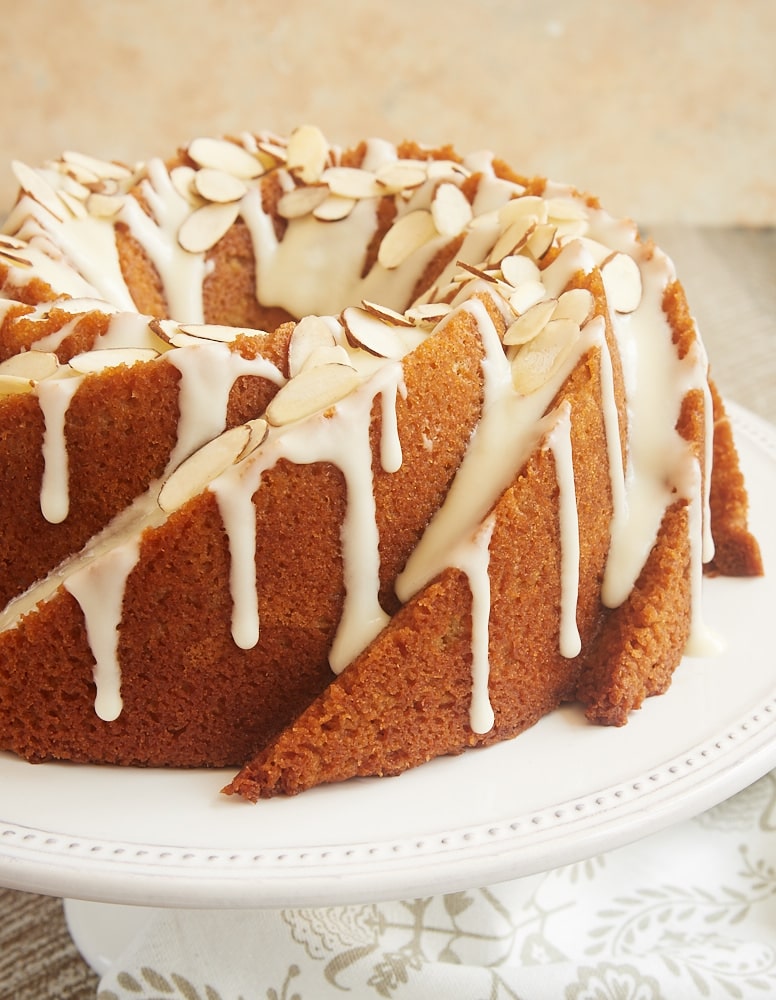


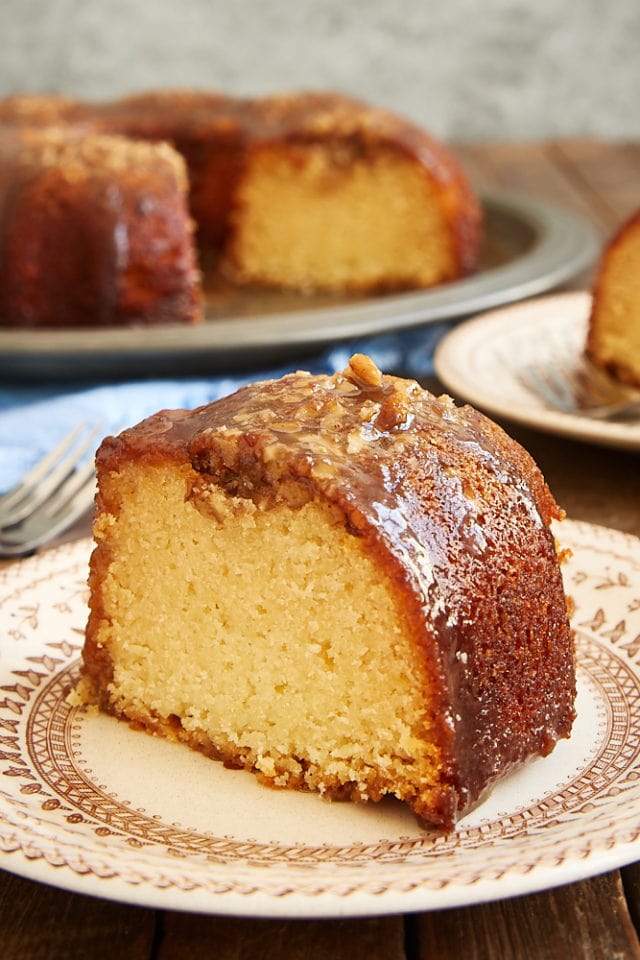

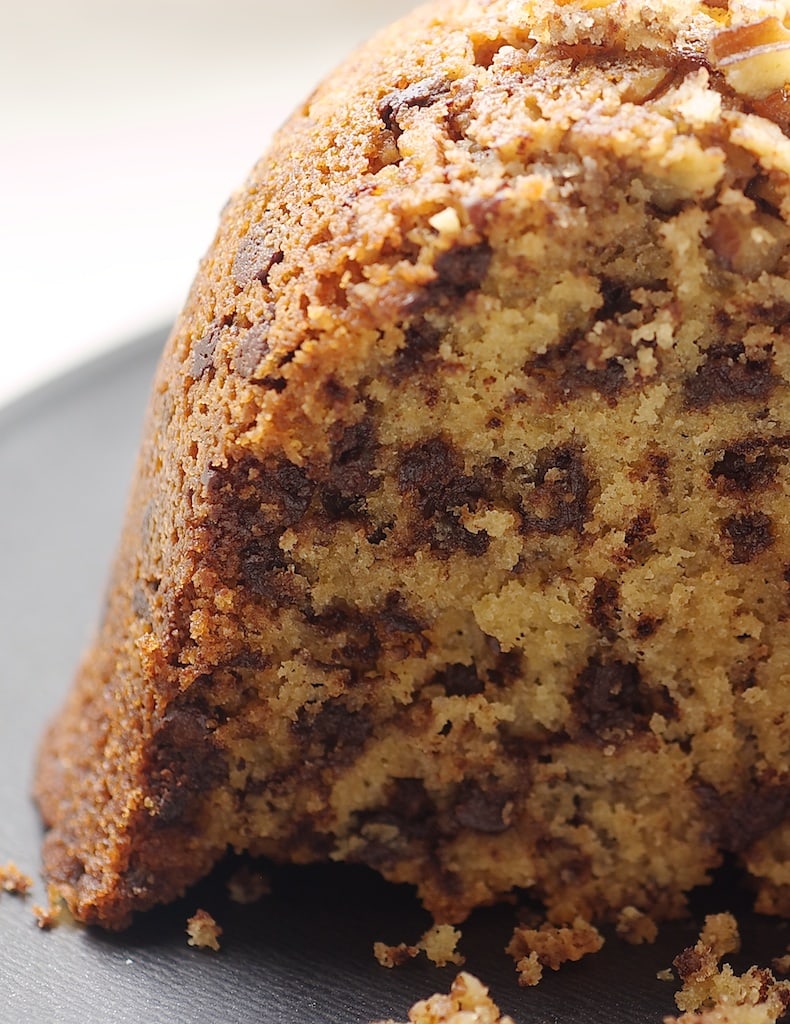
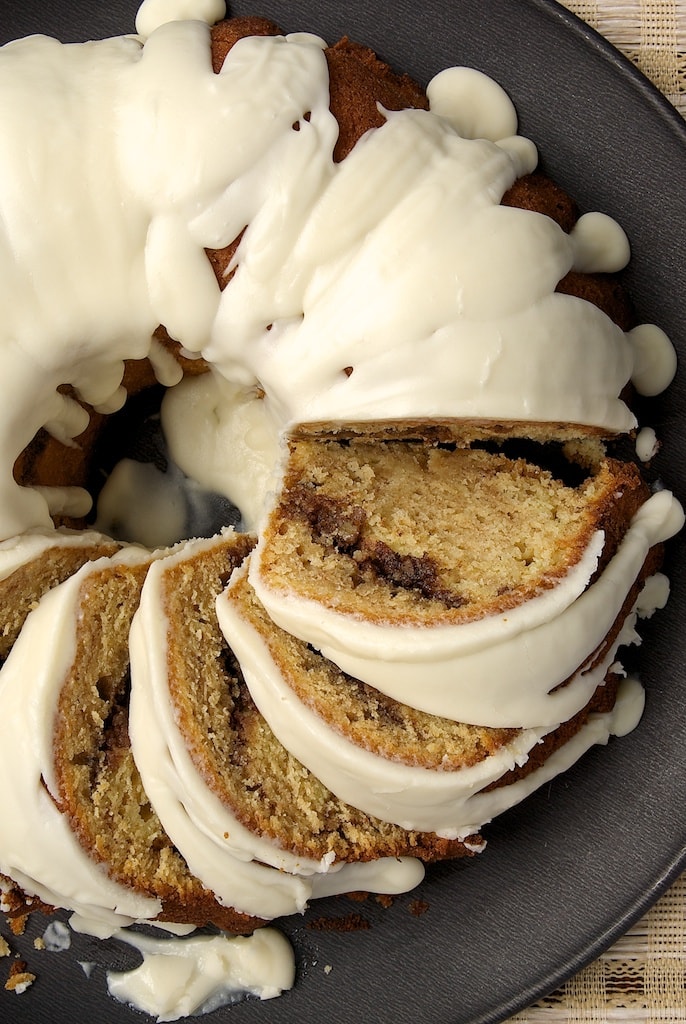
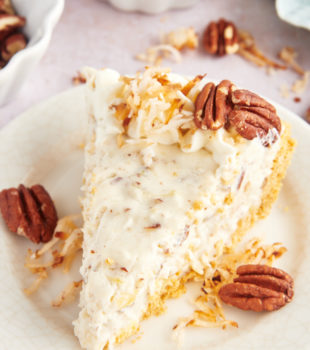
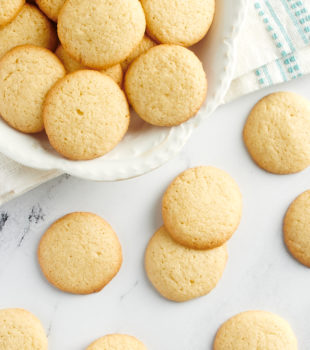
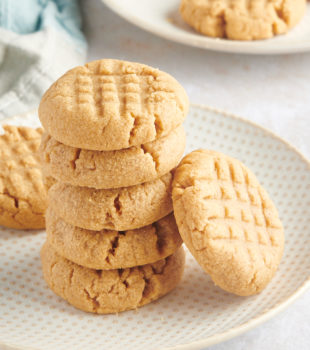


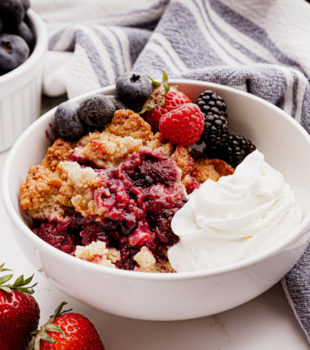
38 Comments on “Bundt Cake Baking Tips”
I love making Bundt cakes – thanks for the handy tips and recipes!
I have actually had better luck using sugar to coat the pan rather than flour, or for chocolate cakes cocoa powder. I spray with a non stick spray then sprinkle granulated sugar in the pan and turn it just like you do with flour.
Bonus is with most cakes you get a nice crunchy sugar coating on the outside of the cake. Not great if you plan on actually frosting but fine if using a glaze or drizzle.
That’s a good tip, Nikki. I’ve previously used cocoa powder for chocolate cakes, but I don’t think I’ve tried sugar.
Excellent tip Jennifer! I’m definitely gonna use that one!
i always do this especially with brownies Yummm
I have a problem with the top (before inverting) being unlevel. When I invert onto a plate, it sits up higher and the edges are not on the plate. How can I fix that? Thanks!
Hi, Linda. I think I understand what you’re saying, that the center is higher than the edges. You can try spreading the batter in the pan so that the edges are a little higher than the center. That will make a difference sometimes.
Hi Jennifer! I’m so glad you! (followed you on Pinterest!). I was making a bundt cake tonight & wanted some extra insight, I learned several things from this article, thank you! I was noticing the 3 pans pictured & wondered what kind these are? I’d love to purchase them. Also, any particular type or brand of sugar you think makes the best cakes? There’s a lot out there! 😉
I’m glad you found me, Amanda! If you follow the link toward the end of the post, you’ll find those pans in my Bundt cake essentials collection at Amazon. I don’t have a favorite brand of sugar, but I usually don’t like to use store brands. I most often use Domino or Imperial.
My bundt cake had a hole like a tunnel all the way around it. What caused this?
Hi, Rhonda. I think you might mean that the bottom of the cake (the top part when it’s still in the pan) is uneven. Some degree of that is not uncommon with Bundt cakes. You can try spreading the batter in the pan in a way that will offset that. Otherwise, you can always trim and even the bottom with a serrated knife after the cake has cooled.
I have a problem where my bundt cakes doesn’t rise all the way and then there small and not full. I’ve tried doubling the batter, but it still sometimes doesn’t rise. How can I fix this?
Hi, Caitlyn. Check the freshness of your baking powder and/or baking soda. Also make sure you’re not over-mixing the batter.
Hello I would,like to use the small individual pans, do I need to lessen the cooking time or just about the same as the regular pan?
Hi, Perni. Depending on the recipe and the size of the pans you’re using, you’ll only need about 1/3 of the usual baking time for a full-size Bundt.
your article is very helpful. i love baking and Nordic pans are my very favorite in the ms y beautiful designs.
i learned a trick from a professional baker i would like to share. spray your pan and place it in the fridge. by the time you mix your batter the pan is cool and the spray has coated the pan well!!!!!!!!
unmolds perfectly every single time
Thanks for sharing your tips, Sonia!
Hi Jennifer! I made a bundt cake today and found the top of the cake to be kind of crunchy like a cookie when I turned it out, but just below the surface the cake was moist. Any idea what might have happened?
Hi, Emily. It sounds like the top got over-baked. If you used a dark pan, that definitely could contribute to that. Also, check that your oven rck isn’t too low in the oven.
Some of my cakes do not come out firm
Hi, Ernie. If you’re not changing anything at all about the recipes, then I would check the accuracy of your measurements as well as the accuracy of your oven’s temperature.
What make a Bundt firm
If using a box cake mix , how do you increase the recipe to fill a larger pan?
Hi, Carrie. It would depend on what recipe you’re using and what size pan. If you’re using a pan larger than the recipe indicates, then you’d just need to scale the ingredients to make more.
Using a mini bundt pan. Batter spread put over the top. I used nife snd trimmed but just didnt look as pretty. Do uou recommed with hole on middle of mini pan?
Hi, Karen. It sounds like your pan was too full. As a general rule, never fill the pans more than 3/4 full, although that can vary depending on the specific recipe. I’m not sure what you mean by the hole in the pan, as all Bundt pans have that.
Hi can you guide me
How do I prevent over mixing if the receipe calls for alternate mixing with flour and buttermilk
Hi! Just be sure you’re not fully mixing each part before adding the next.
I used oil to coat my bundt pan. When the cake was done, I let at cool before turning it onto a plate. The sides were beautiful but the top of the cake didn’t brown at all. It was done, but the top didn’t harden or brown. What did I do wrong?
That could be the pan itself, the recipe, your oven, or a few other possibilities. If it’s a recipe you’ve successfully made previously, then think about what might have been different. With the sides browning well, my first thought is that you’re using a dark-colored pan. Those will bake the parts that touch the sides much faster and make them much browner. It’s also possible the oil you used changed how the cake browned where it came into contact with the oil. I highly recommend a cooking spray with flour (like Baker’s Joy) for baking.
I have a lovely nordic ware bundt pan, but the issue I find is that the really thin raised edges on the cake are tough and burnt, but the rest of the cake is moist and really good. How do I prevent those tough, crisp areas? I’m currently using baker’s joy to line the pan, and I have a thermometer for my oven, so I don’t think the temp is wrong.
If the pan is dark, that could be at least part of the issue. The darker the pan, the more the outside edges tend to over-bake. Otherwise, could you wrap the pan in foil to help protect those specific areas from becoming too brown?
Do you ever use a water bath to bake your bundt cakes?
No, I’ve never tried that.
I have been using a dark pan, and today when I inverted the cake, it had an indentation about halfway down the cake, all around it. It looked like it had a waistline! Any clues? Also, what is your objection to dark pans?
Hi, Ann. I’ve not seen that sort of line around a Bundt cake. If it was a thick batter, maybe it needed to be spread more evenly? Among other things, dark pans bake the outside edges more quickly, which can cause uneven baking and an uneven shape. You can read more here: How to Choose Baking Pans
Hi! The top of my bundt cake and edges (the top in the pan. The bottom flipped over) are overdone, but the middle is barely done. Any ideas?
Hi, Tracy. If you’re consistently having that issue with all your Bundt cakes, it’s most likely your oven or your pan. You can use an oven thermometer to check the accuracy of your oven’s temperature. It’s not uncommon for it to be inaccurate. If you’re using a dark pan, then it will bake the outside edges more quickly, leaving the center under-baked.